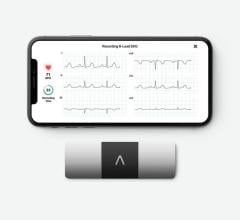April 5, 2013 — One of the leading complaints in the emergency department is chest pain and the timely detection of a heart attack is essential. The Johns Hopkins Hospital presented an abstract at the American College of Cardiology (ACC) conference in March that utilized VentraCor's VectraplexECG System. The abstract, entitled "New Cardiac Electrical Biomarker Measured on 12-Lead ECG Strongly Correlates With High Sensitivity Troponin in Patients Admitted to the Emergency Department to Rule Out Acute Myocardial Ischemic Injury," was presented by Larisa Tereshchenko, M.D., Ph.D., FAHA, of The Johns Hopkins Hospital.
The VectraplexECG System incorporates a novel biomarker, the Cardiac Electrical Biomarker (CEB), which in real-time, detects ECG changes suggestive of an acute myocardial infarction (AMI/heart attack). The CEB is an easy-to-read index number that will continuously display as the patient is monitored, potentially leading to faster treatment and clinician intervention for patients in the emergency department.
Data was analyzed on 130 patients, participants of a prospective cohort study, admitted to the emergency department (ED) to rule out acute myocardial infarction. Overall, 475 ECGs and 489 high sensitivity troponin (HST) measurements were included in the analysis. The CEB showed a strong, positive correlation with (HST) (r=0.560; P=0.0007).
"VectraCor is very excited about the data Johns Hopkins has presented and that our CEB shows a strong correlation to high sensitivity troponin," said Brad S. Schreck, president and CEO of VectraCor. He added, "Our technology is an exciting, non-invasive, real-time technology that will benefit many patients and may help clinicians diagnose more quickly the number one disease in the world."
"In this study we ran a completely blinded analysis of electrocardiograms. The strong correlation between VectraCor's CEB and troponin in a multivariate analysis (after adjustment for other clinical and demographic characteristics of patients) was very impressive. Future use of the VectraplexECG System with CEB holds big promise," stated Tereshchenko.
The current gold standard for AMI detection is a long process which can continue up to 24 hours and involves placing 10 electrodes to produce a 12-lead ECG and measuring cardiac serum biomarkers (i.e. troponin) every three to six hours via invasive blood draws. The VectraplexECG System (FDA-cleared/CE marked) uses only five electrodes to detect ECG changes suggestive of AMI and derives a 15-lead ECG (U.S.) and the 22-lead ECG (EU). This will give the clinician more information with fewer electrodes, while potentially reducing lead placement error.
For more information: www.vectracor.com


 November 21, 2023
November 21, 2023 








